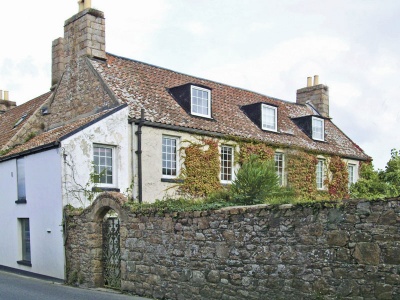Historic Jersey buildings
If you own this property, have ancestors who lived here, or can provide any further information and photographs, please contact us through editorial@jerripedia.org |
Property name
Grouville Court
Other names
Location
Rue a Don, Grouville
Type of property
Complex house with very early origins
Families associated with the property
Datestones
Strangely for a house of this age there are no known datestones
Historic Environment Record entry
Listed building
An important, and complex multiphase house with early origins circa 14th century. Many surviving original features from various phases of the building's evolution. Heightened by one storey in 18th century.
Entrance from roadway is a round arch with name and date of property inscribed as 1527, though this was done in recent times. The house has been much altered, the top segment of an arch on the ground level, now part of a small window, would have been the original front entrance. This shows how much the road level has risen in the intervening time.
The living room fireplace is made up of a mixture of stone details. The lintel appears to be a former door or window lintel and the two quadrant brackets taken from an older fireplace.
An 1880 photograph shows a round topped door which has since been replaced by a drawing window of the same shape.
Interesting internal features. Original ground floor level said to be lower (house was first built into the side of the slope) with top of round arch visible at present cellar level. The living room fireplace is made up of a mixture of stone details. The lintel appears to be a former door or window lintel and the two quadrant brackets taken from an older fireplace. Two stones of an arch or trefoil window above the fireplace may be linked to the demolished La Chapelle de Ste. Marguerite.
According to research by McCormack (2009 Vernacular Architecture Group Conference), this is one of only two examples in Jersey of a developed chamber block. The fireplace with the Payn family arms was probably moved to its current position in 18th century when the chamber block was heightened by a storey to look like a 5 bay house.
Position of the lateral stacks, each with an octagonal chimney on broaches, implies that one fireplace was central to the larger part and the other to the smaller part. This is confirmed by the configuration of the barrel vault in the cellar. Each cellar would originally have been entered separately.
A moulded beam in larger part indicates late 15th century repairs and alterations, possibly reroofing.
To east a three-bay kitchen, one of four detached kitchens recorded in Jersey. Also a very early example of a bipartite or tripartite fireplace. Doorway in east gable likely to be original, kitchen was probably entered from the south (now a window). Dated third quarter of 14th century.
Old Jersey Houses
Although the property has clearly changed considerably since the early 16th century, this house is claimed to be the place where the Royal Court sat in 1518 when forced out of St Helier by the plague.
Bailiff and Governor draw swords - Volume one also notes that this was the place where a Bailiff and a Governor drew swords on each other:
- "The incident is recorded in Les Chroniques and it is reasonably sure that this is the house concerned. The plague was raging in St Helier, and the Royal Court sat here, the house of Jean Payn, Jurat from 1502-36, and the date was 1518.
- "The Bailiff at the time was Hélier de Carteret, son of the Seigneur of St Ouen and his wife, Margaret, nee Harliston, and the Governor was Sir Hugh Vaughan.
- "The Governor and Bailiff were on very bad terms, as a result of Vaughan's misconduct and oppressions, and on this occasion the Governor was striving to obtain possession of Trinity Manor, claiming that the uncle of the previous owner, from whom it had been inherited, had collaborated with the enemy during the French Occupation of 1461-68, and that it was therefore forfeit on grounds of treason. He overlooked the fact that Edward IV had pardoned this offence in 1490.
- "The claim came before the Royal Court, sitting here, and when Vaughan, a most violent man, saw that it was going against him, he ranted and tried to intimidate the Jurats and threatened that if the Bailiff did not find in his favour, he would plunge his sword into de Carteret's stomach, up to the hilt.
- "The Bailiff was not dismayed, and ordered that the doors be opened and the people admitted, and drawing his own sword, grasped Vaughan firmly by the wrist, and said that no matter how many supporters the Governor might have there, if he moved he would be a dead man.
- "The crowd poured in and the Jurats decided against Vaughan, who then threatened to depose the Bailiff, and with much strong language, left the Court; but not before de Carteret had reminded him that he held his Bailiffship direct from the King. Vaughan replied that he was determined to oust de Carteret from his office, even if it cost him all he had, down to his shirt."


